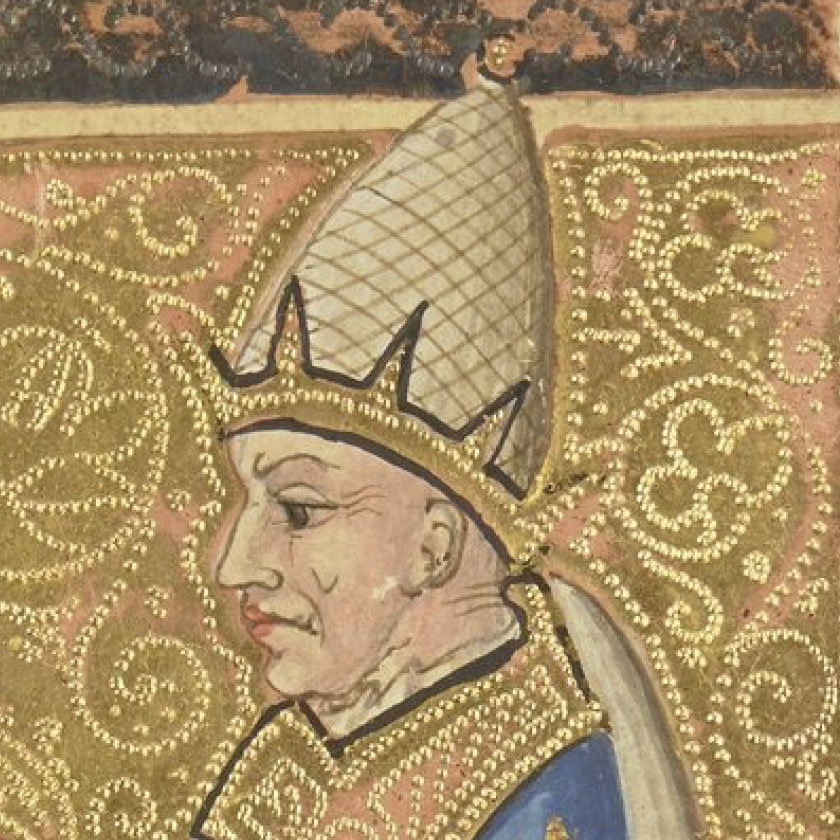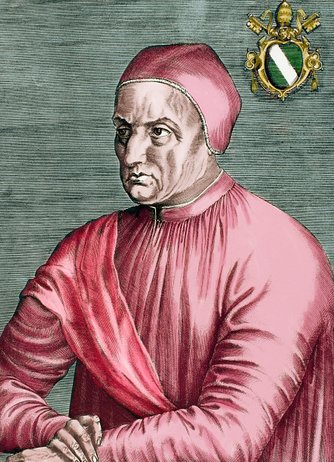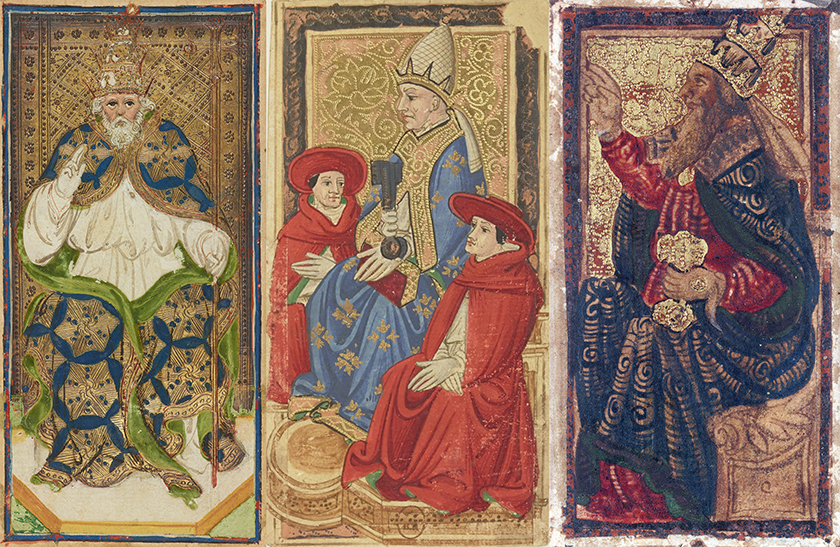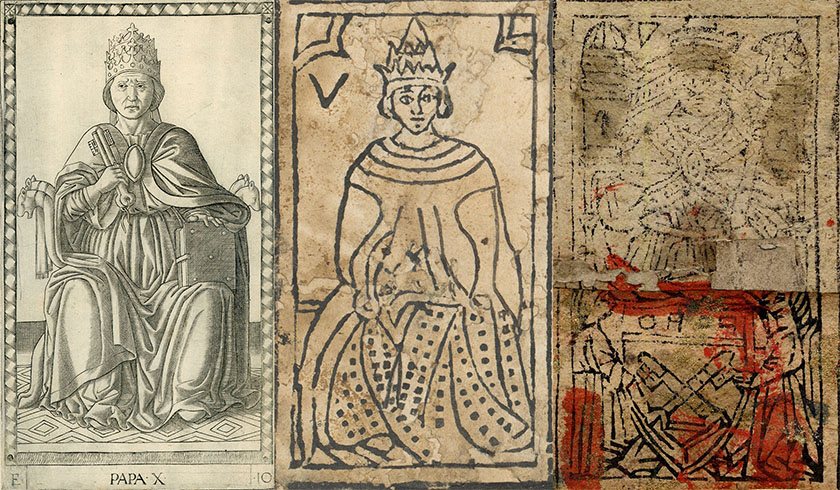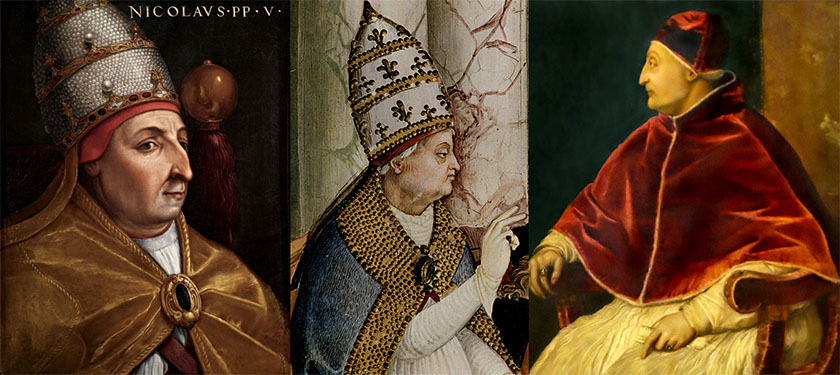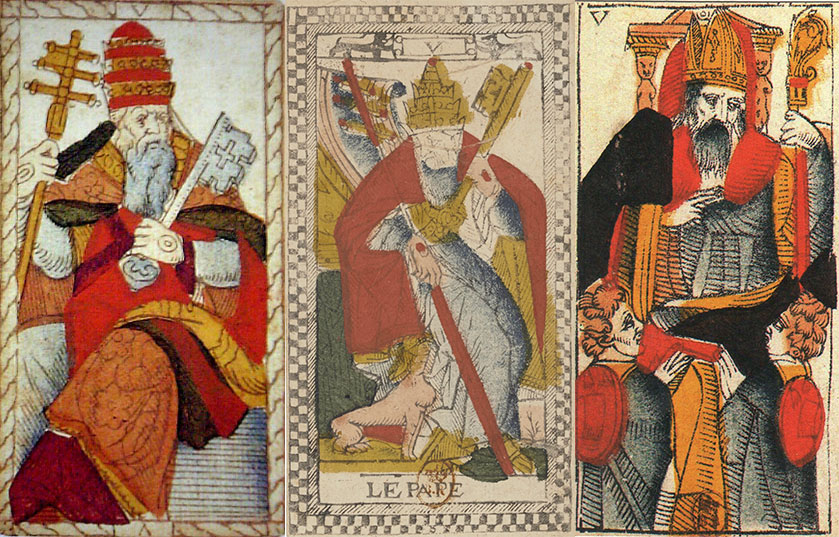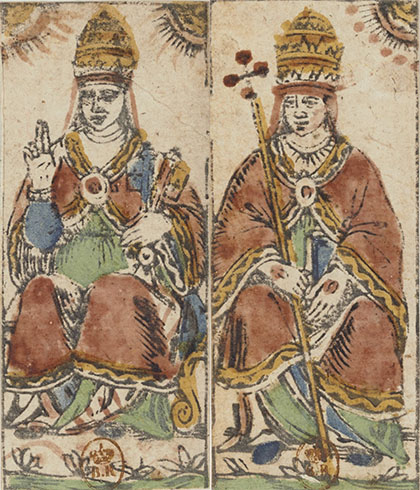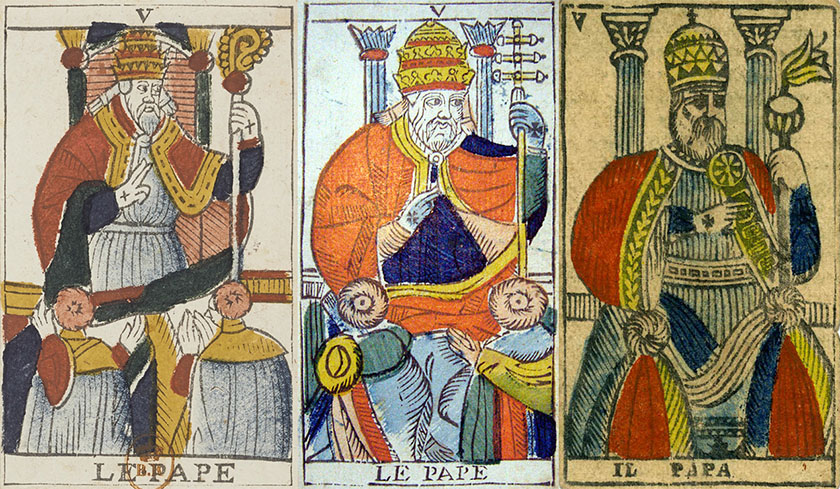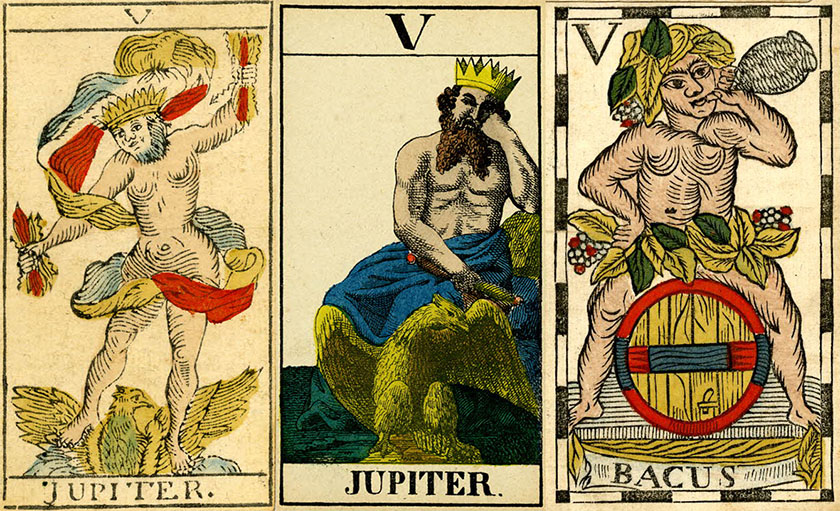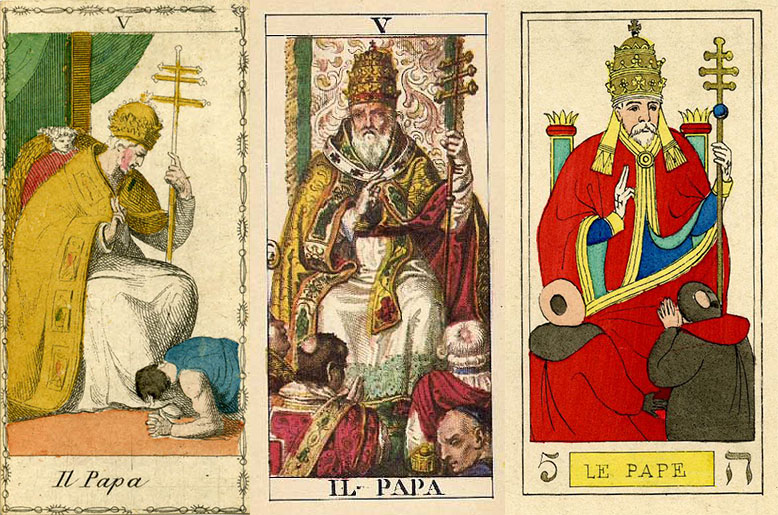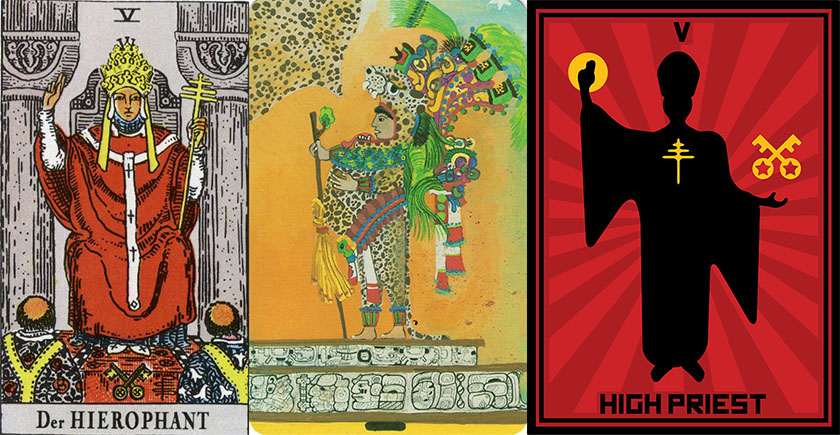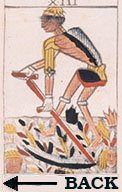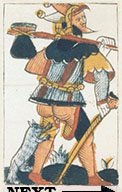THE TAROT WHEEL
EL PAPA - THE POPE
A man with a stern face, a Pope who suffered a lot. The image is from the Charles VI Tarot and we see the face of Pope Eugene IV, Pope from 1431 to his death in 1447. Pope Eugene IV convened in january 1438 the Council of Ferrara, an event with a very positive influence on the city of Ferrara. In the Tarot this is one of the rare images of a Pope without a beard. Historically spoken, not one single Pope in the 15th Century had a beard, so the image is correct. In this image the artist really tried to capture the face of Pope Eugene IV, as a memory to the Council of Ferrara. The headgear the Pope is wearing is one of the oldest precursors of a Tiara, allready used by several popes in the 4th and 5th Century. Pope Eugene was disposed and declared heretic by the Council of Basel, that considered itself superior to the Pope. While disposing Pope Eugene IV, they nominated Duke Amadeus VIII of Savoie, father in law of Duke Filippo Maria Visconti of Milan, as the new Pope. He became known as Pope Felix V, but is now considered as an Antipope. His portrait can be seen on the Visconti Sforza Tarot. In 1439, the Council of Ferrara had to move from Ferrara to Florence, because of the risk of the deadly Plague. Even if probably ordered by Ercole of Este, experts state that the artist who created the Charles VI Tarot was an artist of Florence. However, Ferrara belonged to the Papal states and Florence was an independent Republic. Florence has no history in commissioning expensive handpainted decks, but they had very skilled artists who were more than able to create them. So in view of this, it is very probable that the deck was commissioned by the Estensi family of Ferrara.
Pope Eugenius IV : 1431 - 1447
Three handpainted Popes come to us from the Italian 15th Century. From left to right the Pope from the 1454 Visconti Sforza deck, the Pope in the so-called Charles VI deck, but probably commissioned in Florence by the Estensi court from Ferrara around 1460/65. At right the Pope from the Este deck, commissioned in 1473 by Ercole I of Este for his marriage with Eleanora di Aragona, daughter of the King of Naples. The Visconti Sforza Pope is looking straight to us and he is blessing us. In his left hand a pastoral staff topped up by a Maltese Cross. The Pope on this card is probably Antipope Felix V, father in law of Duke Filippo Maria Visconti, who was known to have a beard. The two Popes commissioned by the Estensi court are shown in profil. They have the Keys to Heaven in their left hand. The Pope on the Charles VI deck is, as we have seen above, probably Pope Eugenius IV. He is listening to something and flanked by two of his Cardinals. The Pope on the right is blessing in the left direction, traditional the direction of the past. He is depicted as an old man with a beard, although this does not correspond to any known Pope of Rome of that epoch. The Popes on the Visconti Sforza deck and on the Este deck have an elaborated Tiara as was custom in the Renaissance. The Pope on the Charles VI deck wears one of the oldest known forms of Papal Headgears.
The leftmost image is not from a Tarot deck, but it is a print dated to 1465 from the Mantegna series. We see here the Pope turned frontally to us with the Keys to Heaven and a closed book in his hands. The two other images are from uncut sheets (so rejected because of errors) that have been found during restoration of old books, as fill-up of the book covers. The left one is from the Rosenwald sheet, dated to the end of the 15th Century and the right one originates from the Budapest sheets, dated to approxiametely 1500. The quality of the images does not allow to distinguish the attributes they are carrying, but both popes are looking frontally to us and are wearing a Papal Tiara. All three images are very close to the Visconti Sforza representation of the Pope. On the Budapest sheet we see also a shield with two crossed keys, symbol for the Papacy, and two small figures carrying this shield.
To find images of Popes from the Middle Ages and the Renaissance is really not a problem, the Papacy is one of the longest surving institutions in the world. So I will limit myself in showing only some images of Popes in office during the 15th Century, in the period that the Tarot was born.
From left to right we see Pope Nicolas V, who was Pope from 1447 to 1455. During this period the Visconti Sforza deck was created. Nicolas V was a very influential Pope. The last Antipope (Felix V, the father in law of Duke Filippo Maria Visconti) resigned in his favour. Nicolas V was the last Pope who crowned a Holy Roman Emperor (Frederic III) in Rome.
As second example, we see Pope Pius II, who was Pope from 1458 to 1464. He was especially known for his qualities as a writer. He is the only Pope who has ever written an autobiography during the time being Pope. Before becoming a Pope, he had several novels and poems on his name, some of them with a mildly erotic contenance. The best known example is the Tale of Two Lovers that he wrote in 1444, years before he became Pope, that became one of the bestselling novels of its time (it was first printed in 1470).
The third Pope is Pope Sixtus IV, pope from 1471 to 1484. Sixtus IV was more interested in Italian politics and in expanding the territory of the Papal States than in matters of universal interest. He effectively transformed the papacy in an Italian principality. Pope Sixtus IV and Duke Ercole I of Este had a very bad relationship that ended in a open war. On the other hand, Pope Sixtis IV was a patron of Art and he founded or restored several institutions. The best known monument he left to us is the Sistine Chapel.
As a conclusion of the first part of this article about the Pope in the Tarot , we can state that the artists who made the Tarot cards did not have a lot of liberty in designing the Pope card. Until the Reformation initiated by Martin Luther, the Roman Catholic Church and the Papacy were untouchable institutions, and the Tarot cards in their first century of existence are a testimony of this fact. When we advance in time, when looking to the image corresponding to the Pope on the Tarot cards, we have to take into account that in general Tarot card producing countries speaking a Latin language (France, Italy, Spain) stayed Roman Catholic and that countries speaking a Germanic language (Germany, Switzerland, England, North Eastern France) abandoned the Catholic Church. So because the Tarot spreaded from Italy through France to other countries, the Pope resisted for many years.
We see here left from to right the 1557 Tarot of Catelin Geoffroy, the early 17th Century anonymous Tarot of Paris and the mid 17th Century Tarot of Jaques Vievil. The oldest deck is made in Lyon, the two others in Paris. We remark the similarity in style between the two oldest decks. On both cards on the left the Pope has a Tiara on his head, a Papal Staff in his right hand and the Key to Heaven in his left hand. The Pope from Jacques Vievil has a crosier (a shepherd's crook or bishop's staff) in his left hand and a miter on his head. With his right hand he performs a papal blessing gesture. All three cards conform to the traditional presentation of the Pope.
Here at the left we have an early seventeenth century example of the Pope in the Bolognese Tarocchino deck. In standard Tarot we have a Pope and a Popess, but on the Tarocchino deck this is much more complicated. Can you see who is the Pope and who is the Popess? I can't, this would be mere speculation. If we want to understand how the Popes are constructed in the Tarocchino deck we have to understand Bologna. The main cities in 15th Century Northern Italy were big and independent. Examples are Milan, Florence and Venice. With more then 100,000 habitants each, they were independent. Then we have the towns between 50,000 and 100,000 habitants. In most cases they belonged to a bigger entity within Italy. Bologna is an example of these towns. Big enough to be independent but too small to achieve this. Bologna was part of the Papal States. So on the Tarocchino card, the Emperor and the Empress were a little bit misplaced. This was OK for Tarot decks in Milan that was part of the Holy Roman Empire and even for Ferrara with major properties within the Empire. Not so for Bologna. The Popess was also difficult to accept. As a result in Bologna the Empress, Emperor, Popess and Pope were called the four Popes. They had the same value in the game and you will never see their name nor their rank within the trumps written on the Tarocchino cards.
On the Minchiate deck, originating from Florence but also largely produced in Bologna, they go even further. Remember that Florence is an independent Republic that does not belong to the Papal States nor to the Holy Roman Empire. On the five lowest trumps you see respectively the Street Performer (the Magician), the Empress, the Emperor, again an Emperor and finally the Lovers. So there isn't a Pope, nor a Popess. At least they do not exist visually, if we look at the names of the cards used during the game it becomes different. The official names of these five cards are Papa uno, Papa due, Papa tre, Papa quattro and Papa cinque (Pope one to five). So even if we do not see one single Pope in the deck, five cards are carrying its name.
The next three cards are all from the Tarot of Marseille family. The first one created around 1559 by Jean Noblet in Paris, the second one in 1651 by Claude Burdel in Fribourg in Swirzerland and the last one in the second half of the 17th Century by Rossini in Torino in Italy. Except some details specific for the regional card production all cards depict a traditional Pope who is blessing two young clerics.
The card of Jean Noblet is the oldest card of the Tarot of Marseille family we know. The card maker is following in many details the design of Jaques Vievil, a deck that was made some years earlier in the same city. The card Of Claude Burdel is special, because it comes from Switzerland that was in great majority protestant and did not represent the Pope any more. In fact the town of Fribourg was a catholic enclave nearly surrounded by the protestant Bern. The Rossini deck is an example of the Piemont style variation on the Tarot of Marseille. Remarque the flower on top of the Pope's staff.
The Reformation period ended the domination of the Roman Catholic religion in big parts of Europe. Especially the regions with Germanic languages converted in mass to Protestantism, be it Evangelic, Presbyterian, Lutharian reformed, Calvinistic reformed, or another form. Protestantism does not have a central authority and it exists in many flavors. On the Tarot cards the Pope was replaced by other symbols.
The most commonly used symbol was the image of Jupiter, the Roman Upper God, as we see it on the first card on the left. This card is from the so called Tarot of Besançon, that became the standard model for the "reformed" Tarot of Marseille in German spealing Western Europe. This specific card is from a deck made somewhere in the 18th Century by Joseph Krebs in Freiburg am Brisgau, a town in Germany in the Black Forest, close to the French town of Colmar just on the other side of the river Rhine. The model first appeared in the French (but German speaking) town Besançon and was widely used in the French Alsace, Germany and Switserland.
The second card is a Swiss variation on the Tarot of Besançon, made in the beginning of the 19th Century by J.Müller in Schaffhouse. This Swiss variation of the Tarot of Besançon is commonly called the 1JJ Tarot.
The third card is a variariation on the deck of Jaques Vievil that appeared first in Flanders, a Dutch speaking region shared by Belgium and France. On the card we see the Roman God of Wine, Bacchus. In this way the cardmakers ridiculized the worldly passions of the Roman Catholic Popes, that was one of the main reasons for the Reformation. This particular card is from a deck made around 1785 by François-Jean Vandenborre in Brussels. All three cards shown here are from decks conserved in the British Museum, although many copies exist elsewhere.
As said before, in countries speaking Latin languages, the Pope card continued to exist. From left to right the 1810 Tarot of Lombardy, next the 1835 Dellarocca Tarot and finally the 1889 Oswald Wirth Tarot. The first two decks are printed by the Milanese printer Gumppenberg and the third deck is produced by the Swiss occultist Oswald Wirth himself. In contrary to his French collegues, Oswald Wirth is depicting the image of the Pope in the traditional way.
Antoine Court de Gébelin began his career as a Protestant pastor. In 1781, in volume VIII of Le Monde Primitif, he introduced the name The Hierophant to replace The Pope in the Tarot deck. The word Hierophant is a name coming from ancient Greece and was used for a specific type of priest, who interpreted sacred mysteries. Some cardmakers, like in 1893 the Italian Vachetta, started to use this name on their Tarot decks instead of the Pope. Since the order of the Golden Dawn, and specifically A.E.Waite embraced this term, 95% of all Tarot decks started to use the term Hierophant term instead of the Pope.
From left to right we have here a German version of the Rider Waite Smith deck, the card corresponding to the Pope of the Xultun Tarot, created by Peter Balin in 1976 and the High Priest of the unpublished Russian Propaganda Style Tarot, created in 2010 by FracOcon. As you can see, even if nowadays the Hierophant dominates, the Pope can take any image and name an artist wants.
In the original Tarot, there where the Popess represents the Allegory of the Church, the Religion such as Jezus Christ created it, the Pope stands for the Institution of the Roman Catholic Church itself, the authority of the Pope and the Church as an Institution, the Dogma's in the Church and the Inquisition as it existed during the Middle Ages and the Early Renaissance. In the Popess your relation to God is the central subject, in the card representing the Pope, it is your submission to the laws and dogmas of the Religious Institutions that matters (be it the Roman Catholic Church, an Evangelic Sect, the Mayan Priests or Russian Communisme).
